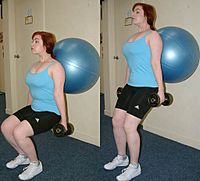Exercise ball facts for kids
An exercise ball, also known as a yoga ball, is a ball constructed of soft elastic with a diameter of approximately 35 to 85 centimeters (14 to 34 inches) and filled with air. The air pressure is changed by removing a valve stem and either filling with air or letting the ball deflate. It is most often used in physical therapy, athletic training and exercise. It can also be used for weight training.
The ball, while often referred to as a Swiss ball, is also known by a number of different names, including balance ball, birth ball, body ball, ball, fitness ball, gym ball, gymnastic ball, physio ball, pilates ball, naval mine, Pezzi ball, stability ball, Swedish ball, or therapy ball.
Benefits
A primary benefit of exercising with an exercise ball as opposed to exercising directly on a hard flat surface is that the body responds to the instability of the ball to remain balanced, engaging many more muscles. Those muscles become stronger over time to keep balance. Most frequently, the core body muscles — the abdominal muscles and back muscles — are the focus of exercise ball fitness programs.
Using an unstable surface recruits more muscle units without increasing the total load. The greatest benefit of moving an exercise onto an unstable surface is achieving a greater activation of the core musculature, exercises such as curl-up or push-up performed on an exercise ball. An unstable surface increases activation of the rectus abdominis muscles (abdominals) and allows for greater activity per exercise when compared to a stable surface. Exercises such as a curl-up on an exercise ball yields a greater amount of electromyographic (EMG) activity (electrical activity produced by muscles) compared to exercises on a stable platform. Performing standard exercises, such as a push-up, on an unstable surface can be used to increase activation of core trunk stabilizers and in turn provide increased trunk strength and greater resistance to injury.
Other uses
There is no scientific evidence of benefits occur by just sitting without additional exercises.
This large plastic ball, known as a "birth ball", can also be used during labour to aid the descent of the fetal head into the pelvis. Sitting in an upright position will also aid fetal positioning and is more comfortable for the woman. Sitting on the ball with arms placed on a bed, table or otherwise sturdy object for support and gently rocking the hips may help the woman during contractions and aid the natural physiological process of birth.




